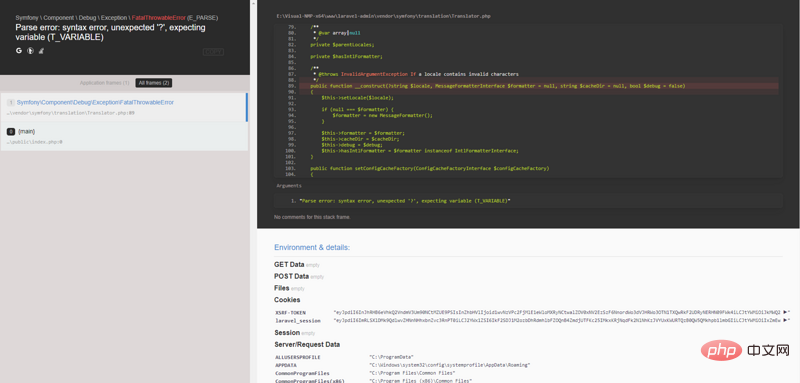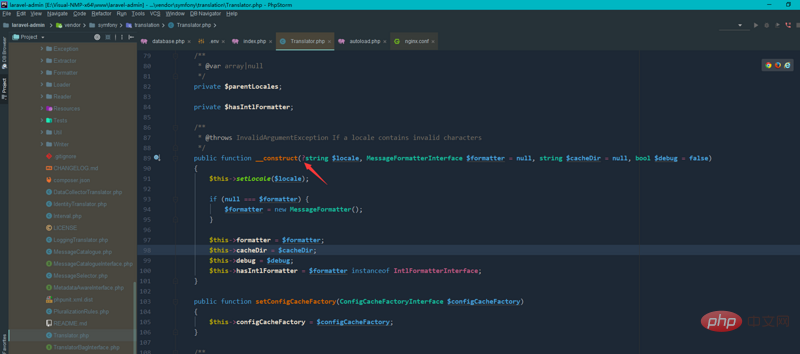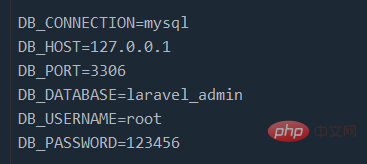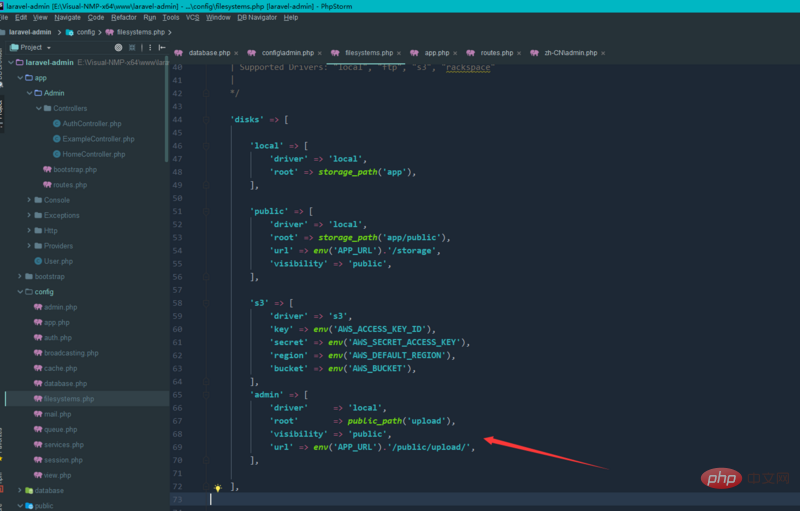Introduction to the installation steps of laravel5.5 and laravel-admin
This article brings you an introduction to the installation steps of laravel5.5 and laravel-admin. It has certain reference value. Friends in need can refer to it. I hope it will be helpful to you.
Configuring laravel-admin
The official tutorial is still no problem, but I also encountered a little pitfall, let’s make a record again
Installing Laravel
Laravel uses Composer to manage dependencies, so make sure Composer is installed on the machine before installation (if it is not installed yet, refer to this document to install it).
Through the Laravel installer
First, install the Laravel installer through Composer:
composer global require "laravel/installer"
Make sure $HOME/.composer/vendor/bin is in the system path (corresponding to Mac The path is ~/.composer/vendor/bin, and the Windows corresponding path is ~/AppData/Roaming/Composer/vendor/bin, where ~ represents the current user's home directory), otherwise the laravel command cannot be called in any path on the command line.
After the installation is complete, you can create a new Laravel application in the current directory with a simple laravel new command. For example, laravel new blog will create a new application named blog and include all Laravel dependencies. . This installation method is much faster than installing through Composer:
laravel new blog
If you have installed an old version of Laravel installer before, you need to update it before you can install the latest Laravel 5.5 framework application:
composer global update
Pass Composer Create-Project
You can also install Laravel applications through Composer's create-project command in the terminal:
composer create-project --prefer-dist laravel/laravel laravel-admin
If you want to download and install other versions of Laravel applications, such as version 5.5, you can use This command:
composer create-project --prefer-dist laravel/laravel laravel-admin 5.5.*。
Note
PHP7.0.30 error is reported, the document says PHP>7.0.0 is enough, but this way of writing seems to be only possible for 7.1.


## This way of writing is not recognized, just remove it OK. Or upgrade to a higher version of PHP. Pay attention to open the openssl
.env file and follow the regular configuration
Be careful not to write the wrong database table name
ThenFirst make sure laravel is installed and the database connection is set correctly. Then enter the laravel directory and executecomposer require encore/laravel-admin
php artisan vendor:publish --provider="Encore\Admin\AdminServiceProvider"
php artisan admin:install

 ##Finally Enter config/filesystems.php and add
##Finally Enter config/filesystems.php and add
'admin' => [
'driver' => 'local',
'root' => public_path('upload'),
'visibility' => 'public',
'url' => env('APP_URL').'/public/upload/',
], Modify language:
Modify language:
'locale' => 'zh-CN',
The above is the detailed content of Introduction to the installation steps of laravel5.5 and laravel-admin. For more information, please follow other related articles on the PHP Chinese website!

Hot AI Tools

Undresser.AI Undress
AI-powered app for creating realistic nude photos

AI Clothes Remover
Online AI tool for removing clothes from photos.

Undress AI Tool
Undress images for free

Clothoff.io
AI clothes remover

Video Face Swap
Swap faces in any video effortlessly with our completely free AI face swap tool!

Hot Article

Hot Tools

Notepad++7.3.1
Easy-to-use and free code editor

SublimeText3 Chinese version
Chinese version, very easy to use

Zend Studio 13.0.1
Powerful PHP integrated development environment

Dreamweaver CS6
Visual web development tools

SublimeText3 Mac version
God-level code editing software (SublimeText3)

Hot Topics
 PHP and Python: Different Paradigms Explained
Apr 18, 2025 am 12:26 AM
PHP and Python: Different Paradigms Explained
Apr 18, 2025 am 12:26 AM
PHP is mainly procedural programming, but also supports object-oriented programming (OOP); Python supports a variety of paradigms, including OOP, functional and procedural programming. PHP is suitable for web development, and Python is suitable for a variety of applications such as data analysis and machine learning.
 Choosing Between PHP and Python: A Guide
Apr 18, 2025 am 12:24 AM
Choosing Between PHP and Python: A Guide
Apr 18, 2025 am 12:24 AM
PHP is suitable for web development and rapid prototyping, and Python is suitable for data science and machine learning. 1.PHP is used for dynamic web development, with simple syntax and suitable for rapid development. 2. Python has concise syntax, is suitable for multiple fields, and has a strong library ecosystem.
 Laravel Introduction Example
Apr 18, 2025 pm 12:45 PM
Laravel Introduction Example
Apr 18, 2025 pm 12:45 PM
Laravel is a PHP framework for easy building of web applications. It provides a range of powerful features including: Installation: Install the Laravel CLI globally with Composer and create applications in the project directory. Routing: Define the relationship between the URL and the handler in routes/web.php. View: Create a view in resources/views to render the application's interface. Database Integration: Provides out-of-the-box integration with databases such as MySQL and uses migration to create and modify tables. Model and Controller: The model represents the database entity and the controller processes HTTP requests.
 PHP and Python: A Deep Dive into Their History
Apr 18, 2025 am 12:25 AM
PHP and Python: A Deep Dive into Their History
Apr 18, 2025 am 12:25 AM
PHP originated in 1994 and was developed by RasmusLerdorf. It was originally used to track website visitors and gradually evolved into a server-side scripting language and was widely used in web development. Python was developed by Guidovan Rossum in the late 1980s and was first released in 1991. It emphasizes code readability and simplicity, and is suitable for scientific computing, data analysis and other fields.
 PHP's Impact: Web Development and Beyond
Apr 18, 2025 am 12:10 AM
PHP's Impact: Web Development and Beyond
Apr 18, 2025 am 12:10 AM
PHPhassignificantlyimpactedwebdevelopmentandextendsbeyondit.1)ItpowersmajorplatformslikeWordPressandexcelsindatabaseinteractions.2)PHP'sadaptabilityallowsittoscaleforlargeapplicationsusingframeworkslikeLaravel.3)Beyondweb,PHPisusedincommand-linescrip
 Solve caching issues in Craft CMS: Using wiejeben/craft-laravel-mix plug-in
Apr 18, 2025 am 09:24 AM
Solve caching issues in Craft CMS: Using wiejeben/craft-laravel-mix plug-in
Apr 18, 2025 am 09:24 AM
When developing websites using CraftCMS, you often encounter resource file caching problems, especially when you frequently update CSS and JavaScript files, old versions of files may still be cached by the browser, causing users to not see the latest changes in time. This problem not only affects the user experience, but also increases the difficulty of development and debugging. Recently, I encountered similar troubles in my project, and after some exploration, I found the plugin wiejeben/craft-laravel-mix, which perfectly solved my caching problem.
 Laravel user login function
Apr 18, 2025 pm 12:48 PM
Laravel user login function
Apr 18, 2025 pm 12:48 PM
Laravel provides a comprehensive Auth framework for implementing user login functions, including: Defining user models (Eloquent model), creating login forms (Blade template engine), writing login controllers (inheriting Auth\LoginController), verifying login requests (Auth::attempt) Redirecting after login is successful (redirect) considering security factors: hash passwords, anti-CSRF protection, rate limiting and security headers. In addition, the Auth framework also provides functions such as resetting passwords, registering and verifying emails. For details, please refer to the Laravel documentation: https://laravel.com/doc
 Laravel framework installation method
Apr 18, 2025 pm 12:54 PM
Laravel framework installation method
Apr 18, 2025 pm 12:54 PM
Article summary: This article provides detailed step-by-step instructions to guide readers on how to easily install the Laravel framework. Laravel is a powerful PHP framework that speeds up the development process of web applications. This tutorial covers the installation process from system requirements to configuring databases and setting up routing. By following these steps, readers can quickly and efficiently lay a solid foundation for their Laravel project.






